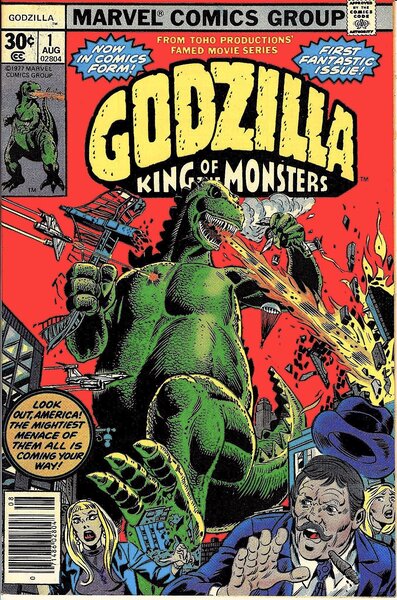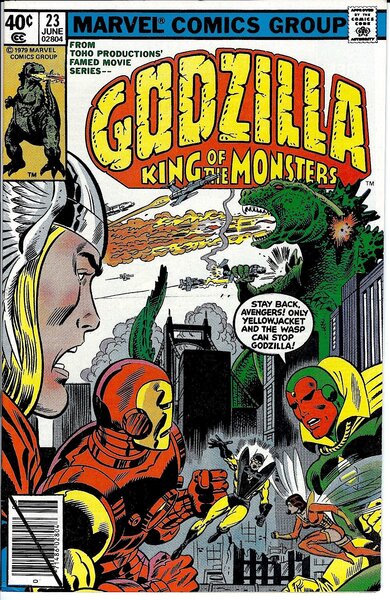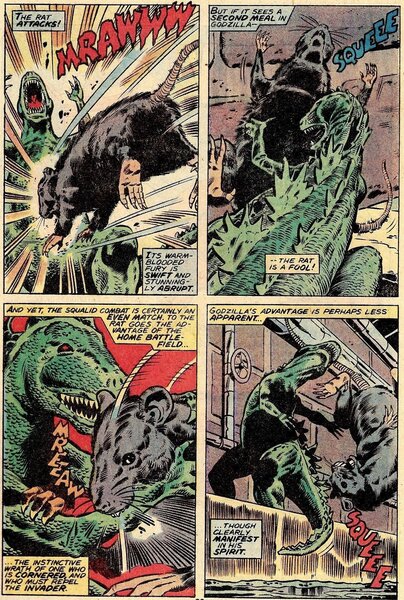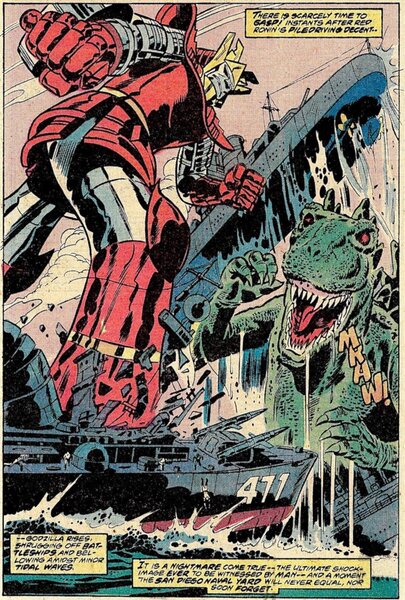Create a free profile to get unlimited access to exclusive videos, sweepstakes, and more!
When Godzilla battled The Avengers: A history of the epic crossover
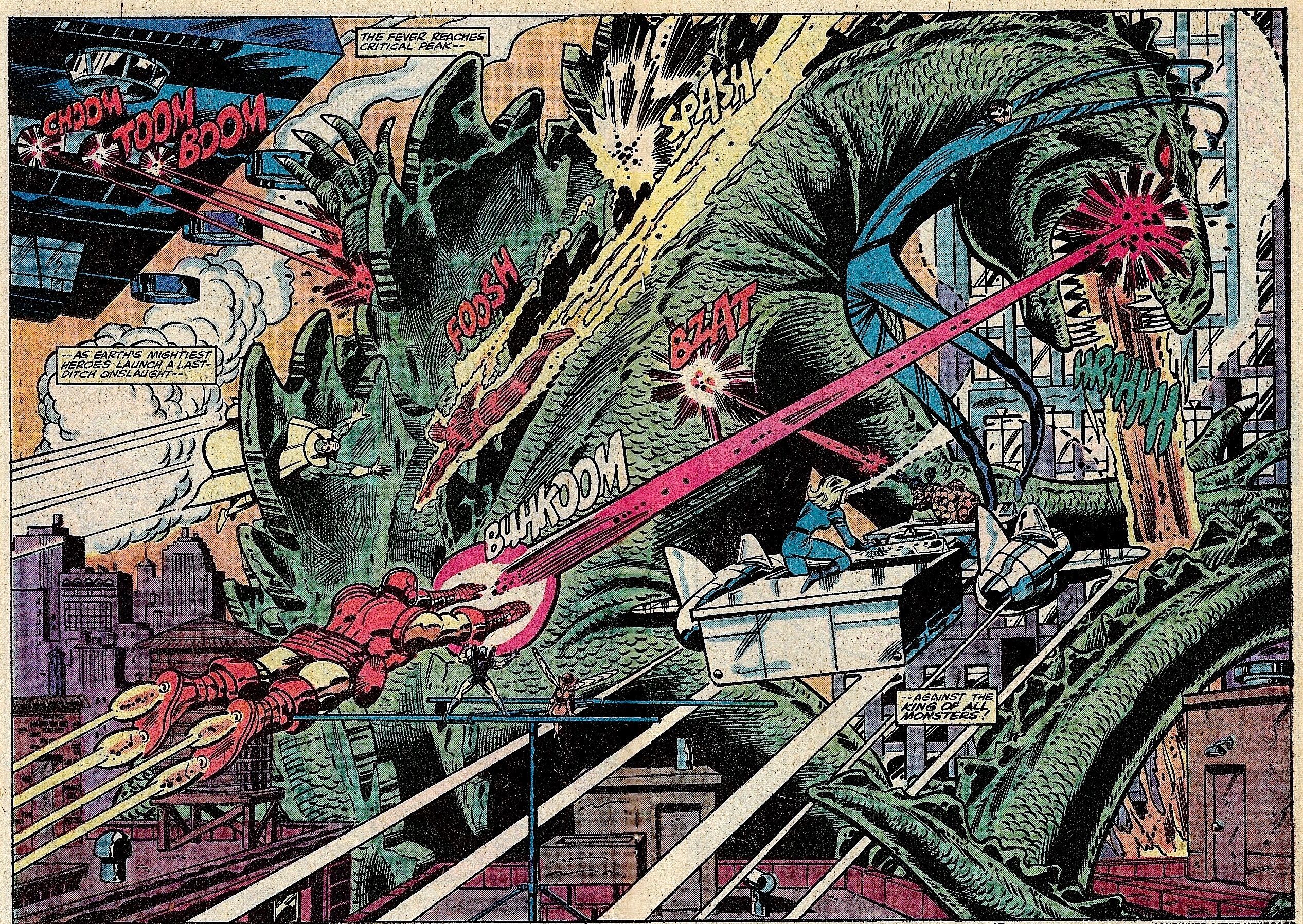
Off the coast of Alaska, a giant iceberg shatters from within. Soon, Godzilla emerges from the frozen debris. Going ashore, the giant creature destroys a section of the Alaskan pipeline and terrorizes everyone in the vicinity before being confronted by the forces of S.H.I.E.L.D., led by Nick Fury's right-hand man, Dum Dum Dugan. Proving to be near-invulnerable, Godzilla heads for the continental United States, landing in Seattle and blazing a path eastward, making stops — and wreaking havoc — in San Francisco, Nevada, and Salt Lake City, with the S.H.I.E.L.D. helicarrier in constant pursuit.
By the end of his cross-country journey, Godzilla will have made it all the way to New York City and battled not just other giant monsters, but also a who's who of superheroes, including the Fantastic Four and key members of the Avengers — Thor, Iron Man, the Vision, Yellowjacket, and the Wasp — before returning to the sea.
Is this the fever dream of some uber-fanboy? A story pitch like the one Patton Oswalt improvised on Parks and Recreation in 2013, detailing a crossover between Star Wars: Episode VII and the Marvel Cinematic Universe? Nope, this storyline did indeed happen — just not on film.
For 24 issues, running from 1977 to 1979, Marvel Comics published Godzilla: King of the Monsters, which saw the title character marauding across U.S. soil for the very first time — long before Roland Emmerich's 1998 film effort and Gareth Edwards's 2014 reboot. But more than just an American odyssey, the comic series was also a sojourn through the Marvel Universe. Written by Doug Moench and illustrated primarily by Herb Trimpe (with Tom Sutton filling in for two issues), Marvel's Godzilla presented Toho Co. Ltd.'s biggest star in a manner that had never been seen before — and would never be seen again.
MOENCH AND THE MONSTER
Moench had already written many stories about monsters, for Marvel titles including Dracula Lives!, Werewolf by Night, and The Frankenstein Monster. And he had great affection for many of the classic movie monsters — though Godzilla was not one of them.
"As a kid, I saw what was probably a re-release of the Raymond Burr-eviscerated version of the first movie," Moench tells SYFY WIRE. "I remember thinking, 'Gorgo was cooler.'"
So the Godzilla comic was not a writing assignment that Moench pursued. Instead, he was tapped for the project by Marvel's then-publisher Stan Lee. Moench was surprised, since, at that time, he was associated with more sophisticated material, like Master of Kung Fu — comics aimed at older, more mature readers. Nevertheless, he says he thought immediately of the kids who lived in his neighborhood. "They were crazy about Godzilla," he explains. "So I told Stan that I would want to put more emphasis on the kid angle, do things that I thought kids would really want to see, in a way that adults would enjoy it too. Stan said, 'I like it! Great idea! Go do it!'"
EVOKING AN ERA
Moench portrayed Godzilla, albeit ambiguously, as basically a force for good. He says he took his cues from the movies of that time period. They include two notorious entries: Godzilla vs. Megalon, released in the U.S. in 1976, in which the Big G teams up with the robot Jet Jaguar to battle the evil Megalon and Gigan, and Godzilla on Monster Island (titled Godzilla vs. Gigan in Japan), which features Godzilla and Anguirus speaking to each other. You read that right — speaking.
Monster Island was actually screened for members of Marvel's creative staff—including Moench and Lee — by Toho executives before the film's U.S. theatrical release in 1977. "It was a piece of crap," Moench recalls, "but Stan was sitting next to me hooting and hollering and clapping. He went crazy during the fight scenes, shouting, 'Go get 'em, Godzy!'"
Noted comic book writer Roger Stern, a Marvel editor at the time, was also at the screening. "Stan was trying to show enthusiasm in front of the Toho execs," Stern explains. "They were three or four Japanese businessmen who looked like they came right out of central casting — short, dressed in dark suits, very buttoned-up and serious. And all of us Marvel people were cracking up, from the movie and from Stan. The Toho execs didn't know what to make of it. At the end, after we've watched this terrible movie with these awful special effects, Stan shouted, 'Take that, Star Wars!' And we cracked up all over again. The Toho execs sat there stone-faced, wondering what was going on with us."
The Godzilla movies of that era also tended to feature a young boy as one of the central characters. To that end, Moench introduced 12-year-old Rob Takiguchi, who would serve as a surrogate for the comic's younger readers. Accompanying his grandfather, scientist Yuriko Takiguchi, who is called in to assist S.H.I.E.L.D., young Rob sees Godzilla as a hero and works to thwart any attempt to harm or kill the creature. Rob's role in the series reaches its apex in issues 7-13, when he takes control of a giant robot called Red Ronin, built to subdue Godzilla, and uses it to come to the monster's aid against S.H.I.E.L.D. and other giant creatures.
Speaking of which — the rest of Toho's stable of monsters, including Mothra, Rodan, and Ghidora, never appear in the comic. "We would have had to pay Toho the same amount for each one," Moench explains. "It was such a shoestring profit margin that there was no way Marvel could afford them."
As a result, Moench created his own oversized monsters for Godzilla to battle, like Batragon, a bat mutated by a deranged geneticist calling himself Doctor Demonicus (in Issues 4-5), as well as Yetrigar, a Sasquatch-like creature exposed to radiation (Issues 10-11), and the Mega-Monsters — three alien beasts sent to Earth by their masters to prepare our planet for conquest (Issues 12-14).
ACROSS THE MARVEL UNIVERSE
According to Moench, the decision to set the Godzilla comic in the Marvel Universe was made before he signed on. "It might have come from Stan, or Archie Goodwin, who was editor in chief at the time," he says. "I said, 'Okay, that kind of makes sense. But I foresee future difficulties doing it that way. Toho owns Godzilla and we own the Marvel characters and now we're going to mix them together—when the [licensing] agreement expires, what's going to happen [to all that material]?' Archie said, 'That's not our problem.' And it did delay the series being reprinted for a long time."
(Marvel reached an agreement with Toho to produce a black-and-white trade paperback collection of the entire series, Essential Godzilla, in 2006, but it was limited to one printing and is now a somewhat rare collector's item.)
Tasked with integrating Godzilla into the Marvel Universe, Moench knew he didn't want to take a "guest star of the month" approach. "Archie suggested that we use some minor Marvel characters that could be in every issue," he says. "We decided on S.H.I.E.L.D. — but then we were told we couldn't have Nick Fury. That was fine with me, because I like Dum Dum Dugan more anyway! He's more fun going up against Godzilla. Nick Fury is too serious. I wanted the comic to be goofy and breezy."
Moench also chose to do something of a travelogue across the U.S. "I figured, it's going to be a Marvel comic done in America, for mostly American readers — they'd probably like to see Godzilla in America," he says. "If it sold in Japan, fine."
Then he got to Issue 3, in which Godzilla arrives in San Francisco, and the suggestions started coming in from above about possible guest stars. "Little did I know when we started," Moench says, "that I would get constant pressure to put in stuff like the Champions — really low-grade Marvel characters, I thought."
A superhero team based in Los Angeles, the Champions starred in their own short-lived series from 1975 to 1977 and consisted of the Black Widow, former X-Men members Iceman and the Angel, Ghost Rider, and the demigod Hercules. The Champions was never a top seller, so the team's appearance in Godzilla was intended to boost reader interest. It didn't work, as the series was canceled several months later — too late to spare Moench from writing a story he would have preferred to skip.
Moench had no qualms about using key elements of the Marvel Universe, as long as they served the stories he wanted to tell. In Issue #17, Dr. Takiguchi and a colleague decide that the best way to contain and study Godzilla is to reduce him in size, so Dr. Henry Pym, formerly Ant-Man, is called upon to provide his shrinking technology. "Hank was the only Marvel character that was my idea [to bring into Godzilla]," Moench says.
The shrinking process works, and Godzilla is placed in a cage about the size of a microwave oven — from which he, of course, later escapes. Roaming the sewers under Manhattan (in Issue 18, which Moench cites as one of his favorites), Little Godzilla finds himself battling a vicious creature that proves to be a real challenge for him — a rat protecting its turf. Eventually, Godzilla starts to grow larger, and when he hits six feet, he ends up on the docks in a physical altercation with Dugan and fellow S.H.I.E.L.D. agent Gabriel Jones, who try to recapture him.
Godzilla continues to grow, reaching 20 feet. Wandering the city, he attracts the attention of the Fantastic Four, who find him to be a formidable opponent (issue #20). "I didn't mind the Fantastic Four," Moench says. "That used to be my favorite Marvel book. There's something about the Fantastic Four that it made sense somehow that they would come in to oppose this creature."
With the FF now in the mix, it was not too great a stretch to bring in another Marvel Universe trope, Doctor Doom's time machine, which Reed Richards uses to send Godzilla "home" — back to the age of the dinosaurs, 95 million years ago, to live in peace away from humans. There, Godzilla encounters the crimson-skinned, Tyrannosaurus-like Devil Dinosaur and his apelike companion, Moon Boy, two then-recent additions to the Marvel Universe created by Jack Kirby (Issues 21-22).
"That one I really didn't want to do," Moench says. "But I was told I really should do it, so I did!" The Devil Dinosaur story was right up Herb Trimpe's alley, however, since he had been drawing Godzilla all along in a style reminiscent of Kirby's.
Moench also displays an overall lack of enthusiasm for the next storyline — which turned out to be the last one. In it, Godzilla, thrust back to the present and restored to his full size, lumbers through Manhattan and faces off against the combined might of the Fantastic Four and the Avengers (Issues 23-24). Even Spider-Man shows up for a cameo. "It just didn't feel like a natural fit," he says.
However, there was one Marvel character — one that readers requested more than any other — that Moench was quite willing to use: the Hulk. But it never happened.
It would have made perfect sense. Both the Hulk and Godzilla were the products of radiation. Both were powerful engines of destruction. And Herb Trimpe was considered one of the definitive Hulk artists, having worked on the character from 1968 to 1975. But according to Moench, Trimpe himself was the obstacle.
"Herb said to me that he was never going to draw the Hulk again," Moench says. "I have no doubt about that memory. I suggested it time and again."
Trimpe, who died in 2015, remembered things differently. In a 2001 interview with G-Fan magazine, he said he didn't know why Godzilla never fought the Hulk. "It's a wonder why we never thought of it at the time or pushed to do it," he said. "I would have loved to have drawn that!"
If Trimpe did indeed boycott the Hulk, it was only for a brief time, since he was drawing the character again regularly in The Defenders and in occasional short-term projects by 1979, as the Godzilla comic was coming to an end.
MONSTER, INTERRUPTED
Marvel's Godzilla concluded with issue 24, but not due to low sales or dissatisfaction from Toho. ("They never objected to a single thing we did," Moench says.) As the contract came up for renewal, Toho decided to increase the fee that Marvel was paying for the publishing rights, to such an extent that Marvel chose to discontinue the series.
"It almost ended after the twelfth issue," Moench reveals. "We had a one-year contract, and I was told that Toho tried to double the licensing fee after one year." Marvel and Toho managed to come to terms for a second year, but couldn't for a third. The Godzilla license eventually ended up at Dark Horse Comics and, more recently, at IDW Publishing.
Today, with both Godzilla and Marvel standing as cinematic powerhouses, and visual effects more spectacular than ever, the notion of a movie crossover, reminiscent of what Moench and Trimpe achieved in their comic-book series 40-plus years ago, no longer seems completely out of the realm of possibility.
"Especially if Disney buys Toho," Moench says with a chuckle. "They're buying everything else, ain't they?"
